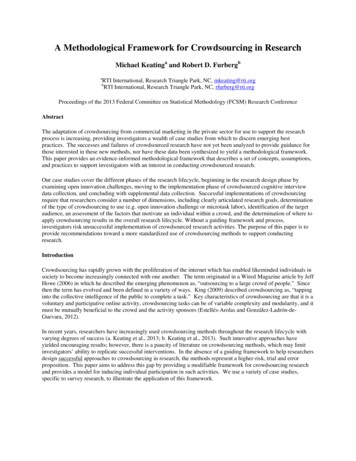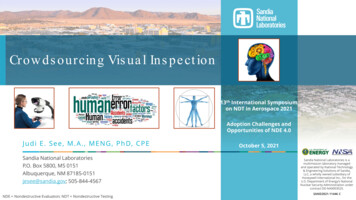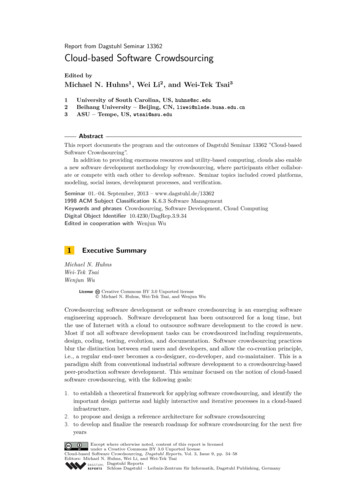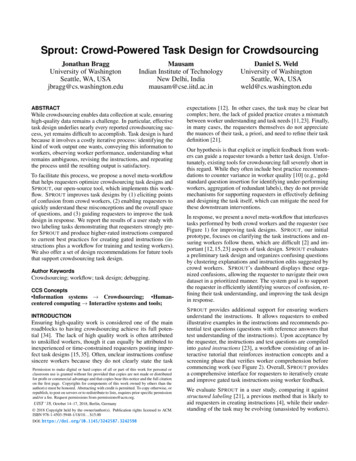
Transcription
A Methodological Framework for Crowdsourcing in ResearchMichael Keatinga and Robert D. FurbergbaRTI International, Research Triangle Park, NC, mkeating@rti.orgRTI International, Research Triangle Park, NC, rfurberg@rti.orgbProceedings of the 2013 Federal Committee on Statistical Methodology (FCSM) Research ConferenceAbstractThe adaptation of crowdsourcing from commercial marketing in the private sector for use to support the researchprocess is increasing, providing investigators a wealth of case studies from which to discern emerging bestpractices. The successes and failures of crowdsourced research have not yet been analyzed to provide guidance forthose interested in these new methods, nor have these data been synthesized to yield a methodological framework.This paper provides an evidence-informed methodological framework that describes a set of concepts, assumptions,and practices to support investigators with an interest in conducting crowdsourced research.Our case studies cover the different phases of the research lifecycle, beginning in the research design phase byexamining open innovation challenges, moving to the implementation phase of crowdsourced cognitive interviewdata collection, and concluding with supplemental data collection. Successful implementations of crowdsourcingrequire that researchers consider a number of dimensions, including clearly articulated research goals, determinationof the type of crowdsourcing to use (e.g. open innovation challenge or microtask labor), identification of the targetaudience, an assessment of the factors that motivate an individual within a crowd, and the determination of where toapply crowdsourcing results in the overall research lifecycle. Without a guiding framework and process,investigators risk unsuccessful implementation of crowdsourced research activities. The purpose of this paper is toprovide recommendations toward a more standardized use of crowdsourcing methods to support conductingresearch.IntroductionCrowdsourcing has rapidly grown with the proliferation of the internet which has enabled likeminded individuals insociety to become increasingly connected with one another. The term originated in a Wired Magazine article by JeffHowe (2006) in which he described the emerging phenomenon as, “outsourcing to a large crowd of people.” Sincethen the term has evolved and been defined in a variety of ways. King (2009) described crowdsourcing as, “tappinginto the collective intelligence of the public to complete a task.” Key characteristics of crowdsourcing are that it is avoluntary and participative online activity, crowdsourcing tasks can be of variable complexity and modularity, and itmust be mutually beneficial to the crowd and the activity sponsors (Estellés-Arolas and González-Ladrón-deGuevara, 2012).In recent years, researchers have increasingly used crowdsourcing methods throughout the research lifecycle withvarying degrees of success (a. Keating et al., 2013; b. Keating et al., 2013). Such innovative approaches haveyielded encouraging results; however, there is a paucity of literature on crowdsourcing methods, which may limitinvestigators’ ability to replicate successful interventions. In the absence of a guiding framework to help researchersdesign successful approaches to crowdsourcing in research, the methods represent a higher-risk, trial and errorproposition. This paper aims to address this gap by providing a modifiable framework for crowdsourcing researchand provides a model for inducing individual participation in such activities. We use a variety of case studies,specific to survey research, to illustrate the application of this framework.
Alignment in the Components of CrowdsourcingBefore beginning any crowdsourcing activity, researchersneed to consider the components of crowdsourcing, eachof which plays an integral part in the success of theapproach. These components include understanding theresearch goal, the audience, the engagement mechanism,the platform, and the sensemaking approach, shown inFigure 1. There is a flow to developing these componentsthat begins with the research goal.Establish the Goal of the ResearchThe research goal is the first component that should beestablished by an investigator as they considercrowdsourcing. Clearly articulating the aim of thecrowdsourcing initiative before beginning should beconsidered best practice. As with any goal, werecommend that the goal be concrete, specific, andmeasurable. By crafting goals with these attributes, theinvestigator can determine whether or not the approachwas successful.Define the Target AudienceFigure 1. Components of Crowdsourcingin ResearchOnce the research goal is established, the audiencerequired to achieve this goal can be defined. Researchersmust know their crowd. Depending upon the research goal, specific audience segments may need to be targeted.For example, if the goal is to determine the mail return rates from the United States Census, then researchers willneed to target individuals capable of contributing data required to conduct this sort of analysis (e.g., data scientists).Alternatively, if the goal is to collect photographic data on tobacco product placement in retail locations, thenresearchers will need to target individuals who are willing to do such tasks (e.g., city dwellers who own smartphonesand are engaged adequately to visit a variety of stores).Identify Suitable Engagement MechanismsKnowing the audience will help the research team target recruiting and participation in the crowdsourcing event andinform the crafting of an effective engagement mechanism. This mechanism should be designed to appeal to thelikely motivations of individuals within the crowd, encouraging them to take part in the crowdsourcing activities.This is one of the most important steps in the planning process. We have further developed a method for craftingeffective engagement mechanisms by extending a simple yet powerful behavioral framework which we discuss inthe next section of the paper.Determine a Technical Platform to Support ActivitiesA suitable platform to support the crowdsourcing activities is identified after the researcher has defined the targetaudience and designed an engagement mechanism. This platform provides a forum for communicating andexchanging value with participants. Selection criteria for a crowdsourcing platform should include the availability ofthe resource to members of the target audience, the ability to integrate relevant engagement mechanisms to driveongoing participation, and the means to distribute incentives after completion of the activities.The diversity of crowdsourcing platforms available on the market is growing exponentially, giving researchers atremendous amount of options (visit http://www.crowdsourcing.org/directory for information about potential
crowdsourcing platform options). Depending upon the crowdsourcing event, researchers can even create their ownplatform for their crowdsourcing event and we discuss a couple of examples below in Case Studies 1 and 2.Inventory Data Quality StandardsFinally, investigators should define standards to characterize useable data, or other crowdsourced returns, that can beapplied toward satisfying the research goal. Ensuring that there is alignment between the incoming data from atarget audience and the research goals will increase the likelihood that these goals will be achieved.The Motive-Incentive-Activation-Behavior Model of Crowdsourcing“Most of economics can be summarized in four words: ‘People respond to incentives.’The rest is commentary.” – Steven E. LandsburgParticipation in crowdsourcing activities is driven by the motives of the individual. In particular situations,incentives can and should be used to activate an individual’s motivations, enabling a specific behavior, such astaking the time required to contribute to a crowdsourced research activity. Understanding how motivations can beinfluenced and activated through intrinsic and extrinsic incentive pathways is a critical aspect of designing effectivecrowdsourced interventions. Rosenstiel (2007) provides a simple model to describe the activation of humanbehavior on the basis of motive-incentive-activation-behavior, or MIAB, which we show in Figure 2.Figure 2. The Motive-Incentive-Activation-Behavior Model of CrowdsourcingThe components of Motivation and Incentive are tightly linked and represent the two fundamental mechanisms forengaging prospective participants in crowdsourcing. The term “motivation” is defined in the Oxford EnglishDictionary as the reason or reasons one has for acting or behaving in a particular way while an “incentive” is definedas a thing that motivates or encourages one to do something. Both intrinsic and extrinsic motivational factors mayplay a role in an individual’s decision to participate and are important considerations in the intervention designphase.Self-Determination Theory (Deci & Ryan, 1985) distinguishes a difference between two different types ofmotivation that result in a given action. Intrinsic motivation refers to doing something on the merit of pleasure orfulfillment that is initiated without obvious external incentives. External motivation is activated by externalincentives, such as direct or indirect monetary compensation or recognition by others.Several authors have revealed motives that explain the motivation of participation in open source projects (Hars,2002; Hertel, 2003; Lakhani, 2003; Lerner, 2002). Applied to crowdsourcing, intrinsic motivators could stem froman individual’s inborn desire and feelings of competence, satisfaction, and enjoyment while the potential to win aprize for participation may act as an external incentive (Leimeister, 2009). Extrinsic activated motivates can befurther divided into two classes: direct compensation and social motives (Vallerand, 1998). Monetary or non
monetary awards, including trophies, medals, or other prizes are examples of direct compensation. Social motivesinclude the expected reaction of individuals whose opinion is valued by the participant, such as friends, partners, oraudience members. Motivation to participate in competitions is greater if members of an individual’s social networkindicate the importance of participating in an event. Within survey research, leverage-salience theory argues thatcommunity involvement in a study has positive effect on individual cooperation and participation (Groves et al.,2000). As applied to crowdsourcing, participants may expect positive reactions from other participants, organizers,or beneficiaries of the activity.The concept of Activation addresses an individual’s decision to initiate a behavior. Of concern in the area ofactivation is the persistence of this state, or the application of continued effort toward achieving a specific goal.Thus, consideration of incorporating activation-supporting components is an additional factor for consideration inthe design of crowdsourcing activities. Examples of activation-supporting components may include providingparticipants with access to the knowledge of experts for inspiration and reference throughout the activation phase.Alternatives to expert knowledge include providing mentorship to participants or supporting an open communityand exchange of knowledge within the network of participants.The term “behavior” is defined by the Oxford English Dictionary as the way in which one acts or conducts oneself.In the context of crowdsourcing activities, there are various behaviors that may be considered desirable outcomes,including original content generation, providing support or collaboration within a network of contributors, or otherconstitutive components required to devise a specific solution.The MIAB model provides investigators considering the use of crowdsourcing methods to support researchactivities with a high-level roadmap of considerations that must be addressed in the design phase of the interventionto ensure successful engagement with participants. Additionally, if things do not go as planned this model canprovide a way to diagnose the causes of the problem and to craft the solution. We will discuss two such examples inthe case studies below.Case Study 1: RTI’s 2012 Research ChallengeIn 2012 RTI International was in the process of planningfor an upcoming omnibus survey. During thequestionnaire design phase the decision was made toexperiment with the potentials of creating acrowdsourced instrument. To complete this task welaunched the RTI 2012 Research Challenge.The goal of this challenge was to create high qualitysurvey questions for the upcoming study. We targetedthe researcher crowd at large, asking for all ideas. Toengage the crowd we used a combination of incentives toappeal to extrinsic motivations. First, participants weretold that if they won the competition then they wouldreceive the response data to their survey questions,demographic data and exclusive publishing rights for oneyear after data delivery. Second, the judges were wellknown in the research community, particularly surveyresearch, giving young researchers the opportunity to gettheir work in front of leaders in the field. RTI created itsown platform for the event, and used a web form on itsSurveyPost blog to receive entries and publishFigure 3: Crowdsourcing Components ofinformation about the event. RTI staff also did heavyRTI’s 2012 Research Challengemarketing on professional listservs, like AAPORnet, toget the word out about the event. We created specificsubmission criteria for the event to ensure that sensemaking would be relatively easy for the judges. We askedresearchers to submit a two page synopsis of their research idea and up to ten survey questions.
This event was very successful and RTI received 76 entries in 23 days. Topics ranged from questions aboutemerging tobacco products to astrological theories about how people meet their mates. Participants in the eventranged from undergraduate students to deans of well-known universities. In the end, the omnibus survey had plentyof material with which to create the questionnaire.Figure 4: Applying the MIAB model to the 2012 Research ChallengeThe MIAB model can help identify some of the reasons why this event may have been successful. Advancing aresearch agenda through professional exposure is a motive for many researchers. Gathering data that can be used forconference presentations and publications can help to advance a research agenda and thus acts as a good incentivefor these researchers. After considering the possibilities,researchers activated and submitted a proposal to the researchchallenge. By doing this, they did the intended behavior,giving RTI’s study a good set of survey questions for theupcoming study.Case Study 2: Crowdsourcing Cognitive InterviewingRecruitment on FacebookNot everything always goes according to plan whencrowdsourcing, and we have found value in using the MIABmodel to help diagnose the sources of problems in ourcrowdsourcing approaches. Such a case arose recently asRTI pilot tested the use of crowdsourcing methods to collectlarge quantities of cognitive interview response data onFacebook. The goal of this study was to determine if wecould collect large quantities of useful cognitive interviewdata using Facebook as a recruitment tool. We used targetedadvertisements that were shown to a crowd of Facebook userswho liked music. To engage the crowd we offered a 5music gift card to appeal to these users’ extrinsic motivationsto acquire more music. RTI created its own platform for theevent, and used Facebook to broadcast the event and a Websurvey to receive the data. The Web survey was highlystructured to ensure that sensemaking could be done indatasets by researchers.Figure 5. Crowdsourcing Components ofCognitive Interview Recruitment on Facebook
Figure 6. Applying the MIAB Model to Cognitive Interview Recruitment on FacebookOne of our assumptions in designing this recruitment approach was that music lovers were motivated to acquiremore music. As a result, we offered the 5 music gift card incentive to appeal to these motivations and encourageactivation and participation in the event. Unfortunately, this incentive was not great enough to lead to participationand after a few days we focused on an alternative approach.Figure 7: Applying the MIAB Model to a Modified Cognitive Interview Recruitment ApproachIn our modified approach we targeted a crowd of Facebook users who liked the American Red Cross. Our thoughtprocess was that people who like the American Red Cross will be motivated by altruistic causes. As a result, weused a 5 donation to the American Red Cross as an incentive for people to participate. This was successful inleading these Facebook users to make the decision to activate and take the Web survey. This was our intendedbehavior and led to the creation of a large volume of useful cognitive interview data.Case Study 3: Collecting Tobacco Retailer Data on Snus in ChicagoOne of the most exciting aspects of crowdsourcing is the ability to collect large quantities of data quickly andrelatively cheaply. This can be done in the data collection phase of a project by collecting supplemental datasetsthat add depth to traditional survey data. For example, if a survey is collecting data on the demand side dynamicssnus tobacco, then it would also be useful to also know where the local snus supply is. In 2012 RTI experimentedwith an approach to collect fine level tobacco supply data from retailers in Chicago.
The goal of this study was to rapidly collect large quantities of local retailer data about snus tobacco. Given the largequantities of retail locations that needed to be called and the short duration of these tasks, we used the crowd ofmicrotask workers on Amazon Mechanical Turk. To engage the crowd we offered a 0.75 reward if the workercalled a retail location to ask if it sold snus tobacco. We used the Amazon Mechanical Turk crowdsourcing platformto manage the data collection and pay workers.Sensemaking was simple since the response data was neatlyorganized in a spreadsheet and could be easily matched toretailer address data.The MIAB model can help to identify some of the reasonswhy this approach may have been successful. Workers whouse Amazon Mechanical Turk are generally motivated tomake money by working jobs posted on the platform.When compared to other jobs posted on the platform, ourresearch team offered a relatively generous incentive for theworkers who chose to complete our tasks. This led to fastactivation. We made data entry easy and straightforward inour job postings, so that data was captured accurately.During the initial phases of data collection we found thatsome workers were not doing the intended behavior whenthey collected tobacco data from retailers. These workerswere including other smokeless tobacco products, like dipor chewing tobacco, in their results. We did not want dataabout these other tobacco products and clarified theinstructions in our job postings. This proved to be a quicksolution to the problem, and it is one more example of howthe MIAB model offers a quick method for researchers toidentify where tweaks may be needed to theircrowdsourcing approach.Figure 8: Crowdsourcing Components ofTobacco Retailer Data CollectionFigure 9: Applying the MIAB Model to Tobacco Retailer Data CollectionIn the end we collected data from retailers quickly and effectively, which holds promise for implementing this sortof rapid supplemental data collection approach on outgoing studies.ConclusionsCrowdsourcing holds promise as a means for researchers to achieve new and ambitious research goals; however,without a guiding methodological framework, researchers run the risk of being unsuccessful in their crowdsourcingendeavors.
Before taking a crowdsourced approach, we encourage researchers to consider and define the components ofcrowdsourcing for the project, all of which flow somewhat naturally from one another. Begin with a goal. This goalwill help the researcher determine who can help achieve that goal. Knowing who will participate will help to choosethe appropriate mechanism to encourage engagement. This mechanism may dictate what platform should be usedfor the crowdsourcing event. This platform will guide what sort of data will come back from the crowd.As the researcher plans their engagement mechanism, they should use the MIAB model to guide this process.Incentives should appeal to the motives of the crowd. Only when motives and incentives are aligned will activationoccur. Once activation occurs, researchers should consider activation supporting mechanisms. Monitoring thebehavior of participants is also encouraged. As our case studies showed, sometimes tweaks will need to be made toensure the researcher gets the proper data back to achieve their 5.16.17.18.19.Behavior [Def. 1]. (n.d.). In Oxford English Dictionary, Retrieved February 2, 2014, n/american english/behavior.Deci, E. L., & Ryan, R. M. (1985). Intrinsic motivation and self-determination in human behavior. New York:Plenum.Estellés-Arolas, Enrique; González-Ladrón-de-Guevara, Fernando (2012), "Towards an IntegratedCrowdsourcing Definition,” Journal of Information Science 38 (2): 189–200.Groves, R. M., Singer, E., Corning, A. (2000). Leverage-salience theory of survey participation. PublicOpinion Quarterly 64 (3): 299-308.Hars, A., and Ou, S. (2002) Working for free? Motivations for participating in open-source projects. (2002)International Journal of Electronic Commerce, (6) 3, 25–39.Hertel, G., Niedner S. & Herrmann, S. (2003), Motivation of software developers in Open Source projects: aninternet-based survey of contributors to the Linux kernel. Research Policy, 32 pp. 1159—1177.Heider, F. (1958) The Psychology of Interpersonal Relations. Mahwah, NJ: Lawrence Erlbaum.Howe, J. (2006, June). The rise of crowdsourcing. Wired, (14.06). Retrieved on January 23, 2013 ds.html.Incentive [Def. 1]. (n.d.). In Oxford English Dictionary, Retrieved February 2, 2014, n/american english/incentive.Keating, M. D., Rhodes, B. B., & Richards, A. K. (2013, March). Applying crowdsourcing methods insocial science research. Presented at Federal CASIC Workshops, Washington, DC.Keating, M. D., Rhodes, B. B., & Richards, A. K. (2013). Crowdsourcing: A flexible method for innovation,data collection, and analysis in social science research. In Social media, sociality, and survey research. (pp.179–201). Hoboken, NJ: John Wiley & Sons, Inc.King, S. (2009). Using Social Media and Crowd-Sourcing for Quick and Simple Market edia-and h.Lakhani, K.R., and Wolf, R.G. (2003). Why hackers do what they do: Understanding motivation and effort infree/open source software projects. MIT Sloan Working Paper no. 4425–03, Cambridge, MA.Landsburg, S. 2012. The Armchair Economist: Economics and Everyday Life. Free Press, New York, NY. Page3.Leimeister, J. M.; Huber, M.; Bretschneider, U. & Krcmar, H. (2009): Leveraging Crowdsourcing: ActivationSupporting components for IT-based ideas competition. Journal of Management Information Systems (JMIS),Ausgabe/Number: 1, Vol. 26, Erscheinungsjahr/Year: 2009. Seiten/Pages: 197-224.Lerner, J., and Tirole, J. (2002) Some simple economics of open source. Journal of Industrial Economics, 50, 2,197–234.Motivation [Def. 1]. (n.d.). In Oxford English Dictionary, Retrieved February 2, 2014, n/american english/motivation.Rosenstiel, L. von. (2007) Basics of Organizational Psychology. Stuttgart, Germany: Schäffer-Poeschel.Vallerand, R.J., and Fortier, M.S. (1998)Measures of intrinsic and extrinsic motivation in sport and physicalactivity: A review and critique. In J.L. Duda (ed.), Advances in Sport and Exercise Psychology Measurement.Morgantown, WV: Fitness Information Technology, pp. 81–101.
process is increasing, providing investigators a wealth of case studies from which to discern emerging best practices. The successes and failures of crowdsourced research have not yet been analyzed to provide guidance for those interested in these new methods, nor have these data been synthesized to yield a methodological framework.










